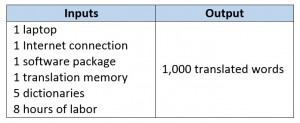Freelancers who feel constrained by market-imposed limitations are not completely helpless. As mentioned in my previous post, the first step to improving income potential involves differentiation; i.e. making yourself stand out from the crowd.
But let’s assume that you have taken that first step. You have carved out your niche. You have made it clear to your clients why you are a special snowflake, and they seem to have agreed, at least to some extent.
Now what?
The next thing that freelance language-service professionals can do is to improve their productivity. But in practice, what does that mean?
Let’s begin with a definition of productivity, then see how it applies to our industry. In the simplest terms, productivity is the amount of output that you get from a given amount of input. It is a ratio, and it is often used to examine the relative efficiency of a production process.
If a process is highly efficient, then you will get a lot of output from a relatively small amount of input. The classic example comes from agriculture. How much corn (output) can a farmer get from an acre of land, in light of the amount of fertilizer, seeds, equipment used, and hours worked (inputs) to grow it? If the inputs can remain constant, while the output (corn) increases, then the farmer has become more productive.
Applying this idea to translation[1], productivity becomes a measure of the number of translated words (output) that a translator can produce in a day, given the technology used and the number of hours worked (inputs). So, for example, the output could be 1,000 translated words completed in one day, using inputs such as a laptop, dictionaries, the Internet, a word-processing software package, translation memory, and eight hours of labor.
This ratio provides a baseline for this translator to understand her current level of productivity. In order to improve on this ratio, the translator needs to decrease (or modify) the amount of inputs needed to achieve the desired amount of output. Or put another way, the translator needs to increase output with the same number of inputs.
So how can this be achieved?
Economists often mention five general ways of improving productivity: investment, innovation, skills development, business development, and competitiveness.
Investment is not just money spent on your inputs, such as a better computer, but also investing in education as well. Innovation involves thinking about new ways in which to do your job better. Skills development is pretty much self-explanatory, while business development focuses on pursuing new opportunities in which to deploy innovation and more developed skills. Finally, competitiveness in this context means determining what the benchmark is for the industry – i.e. the standard for delivering the service in question – and then working to meet and eventually exceed it.
In the language-service industry, there are numerous possibilities for improving productivity, such as developing a faster input method (perhaps talking instead of typing), employing better software, improving translation memory, getting better dictionaries, working in certain fields in which vocabulary is more familiar, etc. After tweaking each of these inputs, translators can keep track of the ones that improve productivity and those that don’t. It is a continuous process, always changing as new input options become available.
One of the results of improving productivity is that it gets at the heart of everything discussed so far in these posts about trying to raise rates. Since the translation market is competitive, and individual translators have limited scope for charging higher rates, then by turning their sights in the other direction – i.e. focusing on productivity – they can achieve the same goal of improving their overall income by modifying their endogenous variables; that is, ones over which they have some control.
This improvement can happen in a couple of ways. First, translators can earn more money while charging the exact same rates, because they are translating more words in the same amount of time. Or another strategy might be to accept lower rates for certain projects that the translator wasn’t able to take previously, because the pay wasn’t good enough for the amount of time required to do the job, thereby increasing overall volume and overall income.
In short, by becoming more productive, translators develop options and some control over their future income.
[1] Again, this post is translation-specific, but the idea of improved productivity can be applied, albeit differently, to interpreting, editing, proofreading and other language services.

